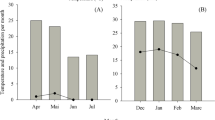Abstract
An experiment was undertaken at two locations in Nigeria to identify the major insect pests of cowpea, assess the yield losses caused by them and recommend profitable control packages. Various combinations of insecticidal applications were tested at four crop growth stages, in conjunction with varieties possessing moderate levels of resistance to one or two insect pests. Flower thrips were the most important pests, followed by pod sucking bugs and foliage pests. The resistance levels of the varieties did not contribute much to reducing yield losses. Yield losses of upto 75% were caused by insects attacking cowpea during the flower bud and flowering stages, and of 23% by insects attacking during pod development. Insects attacking during the foliage growth stage had little effect on yields. Profitable spray schedules which increased yields by about 50–200% were: three sprays at flower budding, flowering and podding (the optimum), the sprays at either flower budding and flowering or flower budding and podding depending on the location, and one spray at either flower budding or flowering stage. Other spray combinations were also viable, but less profitable. Appropriate recommendations for various categories of farmers are given.
Résumé
Un expérience a été conduite en deux localités au Nigéria pour identifier des principaux ravageurs du niébé, évaluer le perte de la récolte qu’ils causent et recommander la lutte chimique utile. Différentes combinaisons d’application d’insecticides sur quatre stades de croissance étaient testées sur des variétés de niveau de résistance moyen à un ou deux ravageurs. Les thrips des fleurs étaient les plus important ravageurs suivis par les punaises succeuses de gousses et les ravageurs des feuilles. Le niveau de résistance des variétés n’a pas beaucoup contribué à la réduction des pertes de récolte. Les pertes des récoltes allant jusq’à 75% étaient causées par les insectes qui attaquent le niébé pendant la formation des boutons floraux et la floraison, 23% par les insectes qui attaquent au cours du développement des gousses. Les insectes qui s’attaquent aux feuilles du niébé ont peu d’effet sur les récoltes. Les bonnes programmations, de pulvérisation d’insecticides qui ont augmenté les récoltes de 50–200% étaient: trois pulvérisations pendant la formation des boutons floraux, à la floraison et à la formation des gousses, deux pulvérisations soit à la formation des gousses et à la floraison ou à la formation des boutons floraux et à la formation des gousses. Compte tenu de localité, un pulvérisation est nécessaire soit à la formation des boutons floraux soit au stade de floraison. D’autres combinaisons de pulvérisation étaient aussi possible mais moins utiles. Des recommendations appropriées aux les differentes catégories d’agriculteurs sont données.
Similar content being viewed by others
References
Alghali A. M. (1987) Effect of time of Chilo pariellus Swinhoe (Lepidoptcra: Pyralidac) infestation on yield loss and compensatory abili ty in sorghum cultivars. Trop. Agric. (Trinidad) 64, 144–148.
Alghali A. M. (1991a) Studies on cowpca farming practices in Nigeria with emphasis on insect pest control. Trop. Pest Manage. (In press).
Alghali A. M. (1991b) Integrated pest management strategy for cowpea production under residual soil moisture in the Bidaareaof northern Nigeria. Trop. Pest Manage. (In press).
Alghali A.M. (1991c) The effects of some agrometcorological factors on flower thrips, Megalurothrips sjostedti Trybom. (Thysanoptera: Thripidae) fluctuations on two cowpea varieties. J. Plant Prot. Trop. (In press).
Alghali A. M. and Osisanya E. O. (1984) Effects of damage by stalk-eyed fly, Diopsis thoracica West (Diptera: Diosidae) on the yield components of the rice crop. Exp. Agric. 20, 225–234.
Jackai L. E. N. and Daoust R. A. (1986) Insect pests of cowpeas. Anna. Rev. Entomol. 31, 95–119.
Jackai L.E.N., Franks P. C. and Alghali A.M. (1987) The development of an insectpestcontrol strategy for cowpea using the electrodyn sprayer. Paper delivered at the 11th International Plant Protection Congress. 4–9 October 1987. Manilla, Philippines.
Jackai L. E. N. and Singh S. R. (1983) Varietal resistance in the integrated pest management of cowpea pests. Insect Sci. Applic. 4, 199–204.
Kyamanywa S. and Ampofo J. K. O. (1988) Effects of cowpea/maize mixed cropping on the incident light at the cowpea canopy and flower thrips (Thysanoptera: Thripidae) population density. Crop Prot. 7, 186–189.
Matteson P. C. (1982) The effects of intercropping with cereals and minimal permethrin application on insectpestsof cowpeaand their natural enemies in Nigeria. Trop. Pest Manage. 28, 372–380.
Nangju D., Flinn J. C. and Singh S. R. (1979) Control of cowpea pests by utilization of insect resistant cultivars and minimum insecticide application. Field Crops Res. 2, 373–385.
Rachie K. O. (1985) Introduction. In Cowpea Research, Production and Utilization (Edited by Singh S. R. and Rachie K. O.), pp. XXI–XXVIII. John Wiley and Sons, New York.
Raheja A. K. and Hayes H. M. (1975) Sole crop cowpea production by farmers using improved practices. Trop. Grain Legume Bull. 1, 6.
Singh S.R. and Taylor T.A. (1978) Pests of grain legumes and their control in Nigeria. In Pests of Grain Legumes: Ecology and Control (Edited by Singh S. R., van Emden H. F. and Taylor T. A.). Academic Press, London.
Author information
Authors and Affiliations
Rights and permissions
About this article
Cite this article
Alghali, A.M. Insecticide Application Schedules to Reduce Grain Yield Losses Caused by Insects of Cowpea in Nigeria. Int J Trop Insect Sci 13, 725–730 (1992). https://doi.org/10.1017/S1742758400007967
Received:
Revised:
Published:
Issue Date:
DOI: https://doi.org/10.1017/S1742758400007967




